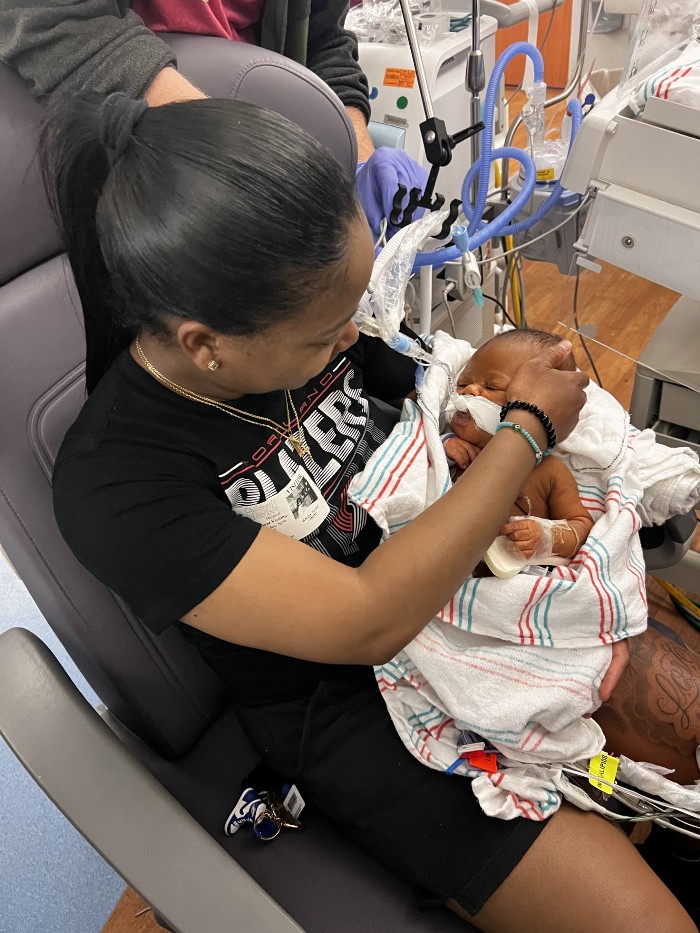
The majority of Teemer’s pregnancy was uneventful, and she felt healthy, happy and excited. But as she neared the 34-week mark, she began experiencing an unrelenting migraine for three consecutive days. Concerned, she sought medical attention at the hospital where she worked, just to ensure her pregnancy was still on track. However, during her visit an ultrasound indicated that her baby’s heart rhythm was irregular. This new development meant Teemer was suddenly considered a high-risk patient, which quickly led to a barrage of additional tests.
Unfortunately, those tests revealed a devastating diagnosis: her baby’s liver was located within his chest rather than in his abdominal area, a condition known as Congenital Diaphragmatic Hernia (CDH).
CDH can occur during fetal development when there is an abnormal opening in the diaphragm, which is the muscle that separates the organs in the abdomen from the organs in the chest. As a result of an absent or partially formed fetal diaphragm, the abdominal organs, which include the stomach, intestines, liver, spleen and kidneys, can move into the chest opening during pregnancy and crowd the baby’s heart and lungs. This can lead to compression and underdevelopment of the lungs, as well as potentially life-threatening breathing difficulties after birth.
The news was shocking, but worse, her baby’s CDH was on his right side—a rare occurrence, which made his condition even more complex.
Unfortunately, Teemer’s hospital in San Antonio did not have the capabilities to treat this specific type of CDH. The attending doctor there candidly told Teemer that her baby’s chances of survival were just 50% given the critical and rare nature of his condition. She was then told that if she delivered her baby there, she might only have a brief moment to hold her newborn before he passed away—with her own chaplaincy team standing by her for support.
Overwhelmed with grief, Teemer tried to process the devastating news about her baby. But as she grappled with all the information she had been given, the Army stepped in with a solution: they would transfer Teemer to The Fetal Center at Children’s Memorial Hermann Hospital in Houston, Texas. The Fetal Center is a national referral center and an international leader in fetal diagnosis, fetal intervention and comprehensive fetal care for infants with congenital anomalies like CDH. The care for CDH at Children's Memorial Hermann Hospital is recognized by the Annals of Surgery as caring for more patients with CDH than most programs in the country. Patients and their families, like Teemer and her baby, benefit from the experience and skill that comes from treating a high volume of CDH cases year after year, including patients who are unable to be managed by other centers. Through the collaboration of affiliated fetal, neonatal and pediatric specialists, the team works together to provide patients with a continuum of care, utilizing high-tech therapies and advanced equipment to manage even the most complex cases effectively.
After arriving in Houston, Teemer was introduced to the affiliated team of specialists who would monitor her throughout the remainder of her pregnancy, including Dr. Anthony Johnson, maternal-fetal medicine specialist, Dr. Matthew Harting, pediatric surgeon specializing in CDH, both affiliated with Children’s Memorial Hermann Hospital.
"We are deeply committed to advancing our understanding of CDH and fetal disorders so that we can care for cases like Noah’s,” Dr. Harting said. “Our goal is to enhance patient outcomes and provide high-quality care, and the results speak for themselves—our risk-adjusted CDH postnatal outcomes place us in the top 10% or higher worldwide, which is a testament to our dedication and expertise."

“He came out crying, kicking and punching,” Teemer recalled.
Prepared for the severity of his condition, a medical team was on standby to ventilate Noah and transport him to the Neonatal Intensive Care Unit (NICU). Children’s Memorial Hermann Hospital’s NICU carries with it a Level IV designation, which means they offer the highest level of advanced and specialized medical care for newborns and premature infants available.
The next day, on April 14, 2023, Noah was placed on an ECMO machine, which pumped and oxygenated his blood outside his body, allowing his heart and lungs to rest. The day after that, Dr. Harting performed a complex surgery to relocate Noah’s liver from the right side of chest to his abdominal area.
“In surgeries for CDH, we first engage in the delicate process of bringing all the organs into place, including the liver, stomach and intestines, and then we repair the hole in the diaphragm, using stitches to carefully sew the muscles together,” Dr. Harting said.
The surgery was a success, but Noah’s tiny body struggled to recover. He remained on ECMO and required multiple white blood cell transfusions to survive. A few days later, Noah was finally removed from the ECMO machine, but he wasn’t yet in the clear. At two weeks old, during an X-ray to determine the source of his swelling belly, Noah stopped breathing. Quick action from the medical team revived him, but he had to be returned to the ECMO machine for a second time.
Teemer was devastated, as she understood the risks of putting her baby on ECMO twice. She leaned on her unwavering faith, the support of her family and loved ones, and her trust in the affiliated medical team at Children’s Memorial Hermann Hospital, determined to believe that Noah would not just survive but thrive.
Through compassionate, high-quality care and the love of his mother, Noah did just that. And on August 8, at nearly 4 months old, he was discharged from the NICU and finally was taken home to San Antonio.
“He’s healthy, gaining weight and doing really well overall,” Teemer said. “He’s a true miracle considering everything he went through to get here.”
"Noah stands as an excellent example of what our team can achieve in the face of high-risk CDH cases,” Dr. Harting said. “His developmental progress is remarkable, and his case underscores our ability to not only successfully manage complex CDH cases, but also to adapt and innovate, using cutting-edge approaches and evidence-based care to guide us, even in the rarest and most unique scenarios."
Noah will be coming back to Children’s Memorial Hermann Hospital periodically for follow-up appointments, and Teemer hopes that by sharing her story, she can encourage other families with children in the NICU to hold onto their faith and remain steadfast. As she looks at Noah today, she sees a living testament to the belief that miracles do happen, and she hopes that others can find strength and hope in her journey.
“Children’s Memorial Hermann Hospital provided the exceptional care my baby needed,” Teemer said. “Knowing that he was in great hands and holding onto my faith is what kept me going through this challenging time.”
Learn more about Children Memorial Hermann Hospital’s CDH program »